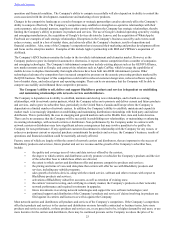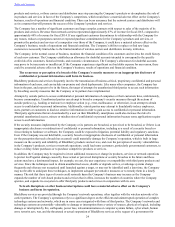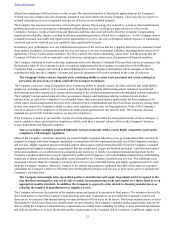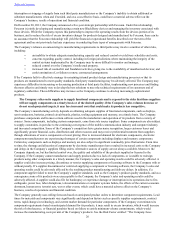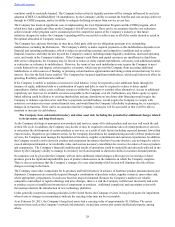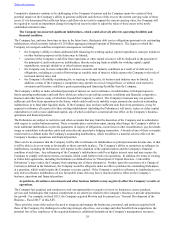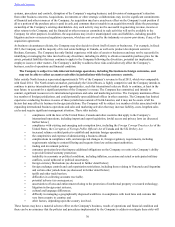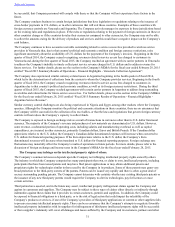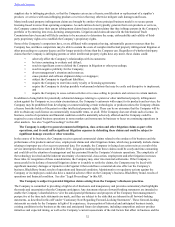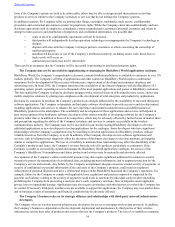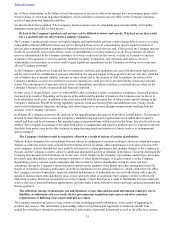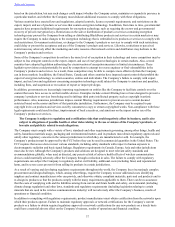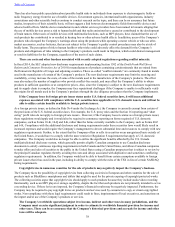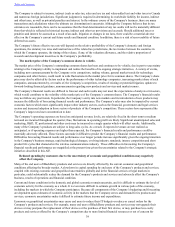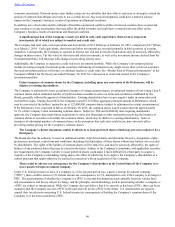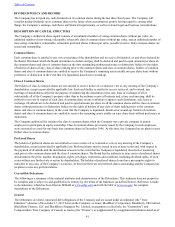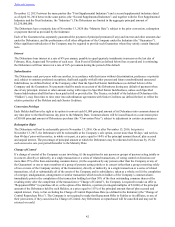Blackberry 2015 Annual Report Download - page 42
Download and view the complete annual report
Please find page 42 of the 2015 Blackberry annual report below. You can navigate through the pages in the report by either clicking on the pages listed below, or by using the keyword search tool below to find specific information within the annual report.
Table of Contents
33
likely success of mitigation strategies relating to such factors. These forward-looking statements are subject to the inherent risk
of difficulties in forecasting the Company’s financial results and performance for future periods, particularly over longer
periods, given the ongoing transition in the Company's business strategy and rapid technological changes, evolving industry
standards, intense competition and short product life cycles that characterize the wireless communications industry. These
difficulties in forecasting the Company's financial results and performance are magnified at the present time given the
uncertainties related to the Company's strategic initiatives described in this AIF.
Given the dynamics of the wireless communications industry, the Company’s financial results may not follow any past trends.
In particular, the Company’s entry into new markets or changes to the Company’s products, services and licensing models can
increase the difficulty of forecasting financial results. Significant unanticipated sales and marketing, R&D, IT, professional and
other costs, writedowns and impairment charges may be incurred or take place in a single quarter, which can affect results.
Additionally, many of the Company’s products are, among other things, subject to long development, new product approval and
certification, and sales cycles. In addition, the Company is engaged in an industry that is highly competitive and rapidly
evolving, and has experienced, and expects to continue to experience, intense competition from a number of companies. As a
result, if expected revenues are not realized as anticipated, if new product introductions are delayed or are not as well received
by the market as anticipated, or if operating expenses are higher than expected, the Company’s actual financial results could be
materially adversely affected. These factors can make it difficult to predict the Company’s financial results. Consequently,
actual results may differ materially from those expressed or implied by the Company’s forward-looking statements and may not
meet the expectations of analysts or investors, which can contribute to the volatility of the market price of the Company’s
common shares. Despite the Company’s cautions in each earnings release, earnings conference call and securities filings that
contains forward-looking statements that the risks relating to such statements should be considered carefully and that
shareholders should not place undue reliance on forward-looking statements, if results expressed or implied in the forward-
looking statements are not realized, or the Company updates its forward-looking statements at a later time, the Company may
nevertheless be subject to potential securities litigation or enforcement action. For example, please see the section entitled
“Legal Proceedings” in this AIF for an example of such securities litigation the Company is involved in. Regardless of the
Company’s views of the merits of such actions that may be filed against the Company, securities litigation is costly, time-
consuming and may be unpredictable, and could divert the attention of management and key personnel from the Company’s
business operations. If the Company is unsuccessful in its defense of securities litigation claims or is unable to settle the claims,
the Company may be faced with significant monetary damages that could have a material adverse effect on the Company’s
business, results of operations and financial condition. Administrative or regulatory actions against the Company or its
employees could also have a material adverse effect on the Company’s business, results of operations and financial condition.
The Company may not be able to obtain patents or other intellectual property protections necessary to secure its
proprietary technology and products.
The Company’s commercial success depends upon its ability to develop new or improved technologies and products, and to
successfully obtain or acquire patent or other proprietary or statutory protection for these technologies and products in Canada,
the United States and other countries. The Company seeks to patent concepts, components, protocols and other inventions that
are considered to have commercial value or that will likely yield a technological advantage. The Company owns rights to an
array of patented and patent pending technologies relating to wireless communication and embedded software in the United
States, Canada and other countries. The Company continues to devote significant resources to protecting its proprietary
technology. However, the Company may not be able to continue to develop technology that is patentable, patents may not be
issued in connection with the Company’s pending applications and allowed claims by the Company may not be sufficient to
protect its technology. Furthermore, any patents issued could be challenged, invalidated or circumvented and may not provide
proprietary protection or a competitive advantage.
A number of the Company’s competitors and other third parties have been issued patents, and may have filed patent
applications or may obtain additional patents and proprietary rights, for technologies similar to those that the Company has
made or may make in the future. Public awareness of new technologies often lags behind actual discoveries, making it difficult
or impossible to know all the relevant, third-party patent applications at any particular time. For example, patent applications
filed in the United States before November 29, 2000 are not disclosed to the public until issued as patents, unless voluntary
publication is applied for. Even the majority of applications filed after November 29, 2000 do not become public until 18
months from the first filing date for which a benefit is sought. Consequently, the Company cannot be certain that it was the
first to develop the technology covered by its pending patent applications or that it was the first to file patent applications for
the technology. In addition, the disclosure in the Company’s patent applications may not be sufficient to meet the statutory
requirements for patentability in all cases. As a result, there can be no assurance that the Company’s patent applications will
result in patents being issued.
Protection of the rights sought in published patent applications can be costly and uncertain and can involve complex legal and
factual questions. In addition, the laws of certain countries in which the Company’s products and services are sold or licensed
do not protect intellectual property rights to the same extent as the laws of Canada or the United States. Therefore, the breadth
of allowed claims and the scope of protection provided by the Company’s patents, and their enforceability, cannot be predicted.


